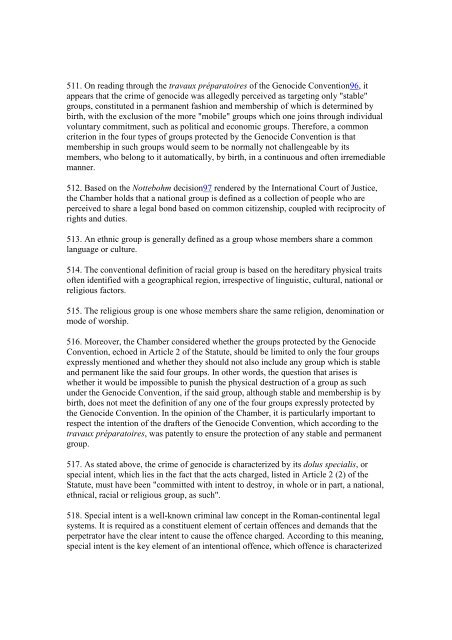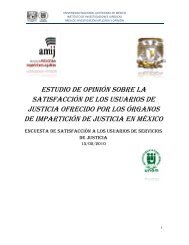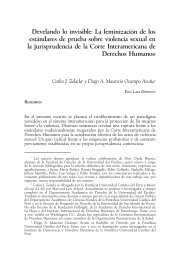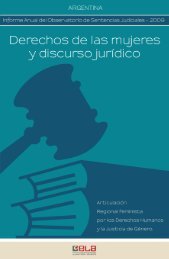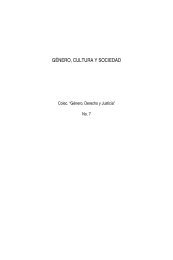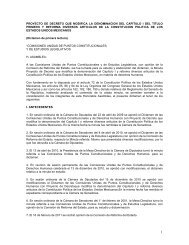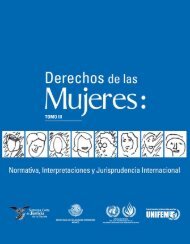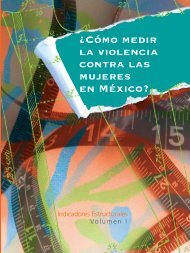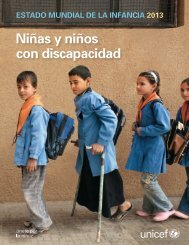511. On reading through the travaux préparatoires of the Genocide Convention<strong>96</strong>, itappears that the crime of genocide was allegedly perceived as targeting only "stable"groups, constituted in a permanent fashion and membership of which is determined bybirth, with the exclusion of the more "mobile" groups which one joins through individualvoluntary commitment, such as political and economic groups. There<strong>for</strong>e, a commoncriterion in the four types of groups protected by the Genocide Convention is thatmembership in such groups would seem to be normally not challengeable by itsmembers, who belong to it automatically, by birth, in a continuous and often irremediablemanner.512. Based on the <strong>No</strong>ttebohm decision97 rendered by the <strong>International</strong> Court of Justice,the Chamber holds that a national group is defined as a collection of people who areperceived to share a legal bond based on common citizenship, coupled with reciprocity ofrights and duties.513. An ethnic group is generally defined as a group whose members share a commonlanguage or culture.514. The conventional definition of racial group is based on the hereditary physical traitsoften identified with a geographical region, irrespective of linguistic, cultural, national orreligious factors.515. The religious group is one whose members share the same religion, denomination ormode of worship.516. Moreover, the Chamber considered whether the groups protected by the GenocideConvention, echoed in Article 2 of the Statute, should be limited to only the four groupsexpressly mentioned and whether they should not also include any group which is stableand permanent like the said four groups. In other words, the question that arises iswhether it would be impossible to punish the physical destruction of a group as suchunder the Genocide Convention, if the said group, although stable and membership is bybirth, does not meet the definition of any one of the four groups expressly protected bythe Genocide Convention. In the opinion of the Chamber, it is particularly important torespect the intention of the drafters of the Genocide Convention, which according to thetravaux préparatoires, was patently to ensure the protection of any stable and permanentgroup.517. As stated above, the crime of genocide is characterized by its dolus specialis, orspecial intent, which lies in the fact that the acts charged, listed in Article 2 (2) of theStatute, must have been "committed with intent to destroy, in whole or in part, a national,ethnical, racial or religious group, as such".518. Special intent is a well-known criminal law concept in the Roman-continental legalsystems. It is required as a constituent element of certain offences and demands that theperpetrator have the clear intent to cause the offence charged. According to this meaning,special intent is the key element of an intentional offence, which offence is characterized
y a psychological relationship between the physical result and the mental state of theperpetrator98.519. As observed by the representative of Brazil during the travaux préparatoires of theGenocide Convention,"genocide [is] characterised by the factor of particular intent to destroy a group. In theabsence of that factor, whatever the degree of atrocity of an act and however similar itmight be to the acts described in the convention, that act could still not be calledgenocide."99520. With regard to the crime of genocide, the offender is culpable only when he hascommitted one of the offences charged under Article 2(2) of the Statute with the clearintent to destroy, in whole or in part, a particular group. The offender is culpable becausehe knew or should have known that the act committed would destroy, in whole or in part,a group.521. In concrete terms, <strong>for</strong> any of the acts charged under Article 2 (2) of the Statute to bea constitutive element of genocide, the act must have been committed against one orseveral individuals, because such individual or individuals were members of a specificgroup, and specifically because they belonged to this group. Thus, the victim is chosennot because of his individual identity, but rather on account of his membership of anational, ethnical, racial or religious group. The victim of the act is there<strong>for</strong>e a member ofa group, chosen as such, which, hence, means that the victim of the crime of genocide isthe group itself and not only the individual100.522. The perpetration of the act charged there<strong>for</strong>e extends beyond its actual commission,<strong>for</strong> example, the murder of a particular individual, <strong>for</strong> the realisation of an ulteriormotive, which is to destroy, in whole or part, the group of which the individual is just oneelement.523. On the issue of determining the offender's specific intent, the Chamber considersthat intent is a mental factor which is difficult, even impossible, to determine. This is thereason why, in the absence of a confession from the accused, his intent can be inferredfrom a certain number of presumptions of fact. The Chamber considers that it is possibleto deduce the genocidal intent inherent in a particular act charged from the generalcontext of the perpetration of other culpable acts systematically directed against that samegroup, whether these acts were committed by the same offender or by others. Otherfactors, such as the scale of atrocities committed, their general nature, in a region or acountry, or furthermore, the fact of deliberately and systematically targeting victims onaccount of their membership of a particular group, while excluding the members of othergroups, can enable the Chamber to infer the genocidal intent of a particular act.524. Trial Chamber I of the <strong>International</strong> <strong>Criminal</strong> <strong>Tribunal</strong> <strong>for</strong> the <strong>for</strong>mer Yugoslaviaalso stated that the specific intent of the crime of genocide
- Page 2 and 3:
1.2. The Indictment1.3. Jurisdictio
- Page 4 and 5:
eports2 which indicated that acts o
- Page 6 and 7:
3. Jean Paul AKAYESU, born in 1953
- Page 8 and 9:
16. Jean Paul AKAYESU, on or about
- Page 10 and 11:
Counts 7-8(Crimes Against Humanity)
- Page 12 and 13:
c) Deliberately inflicting on the g
- Page 14 and 15:
1.4. The Trial1.4.1. Procedural Bac
- Page 16 and 17:
y the opening statement for the Def
- Page 18 and 19:
y the Tribunal for crimes related t
- Page 20 and 21:
38. Regarding the Gishyeshye meetin
- Page 22 and 23:
witness was lying because he or she
- Page 24 and 25:
in the commune. His de facto author
- Page 26 and 27:
70. Apart from asking the prefect t
- Page 28 and 29:
84. According to the testimony of D
- Page 30:
Scores of political leaders were im
- Page 33 and 34:
his listeners to avoid the error of
- Page 35 and 36:
111. The killing of Tutsi which hen
- Page 37 and 38:
killed on the grounds that the foet
- Page 39 and 40:
128. In conclusion, it should be st
- Page 41 and 42:
Witness statements137. During the t
- Page 43 and 44:
protection of witnesses issued by t
- Page 45 and 46:
covered anyone who had anti-Tutsi t
- Page 47 and 48:
Tutsi and the Tutsi were accused of
- Page 49 and 50:
as "two armies", "two belligerents"
- Page 51 and 52:
"The primary criterion for [definin
- Page 53 and 54:
180. Many witnesses testified regar
- Page 55 and 56:
stated in that Decision, it did not
- Page 57 and 58:
deeds. For these reasons, the Chamb
- Page 59 and 60:
Concerning the allegation that at l
- Page 61 and 62:
turned over alive to Akayesu, and t
- Page 63 and 64:
younger brothers. He stated that he
- Page 65 and 66:
237. Karangwa testified under cross
- Page 67 and 68:
three brothers lie on their stomach
- Page 69 and 70:
known as Usuri (phonetic spelling)
- Page 71 and 72:
Karangwa's explanation for the inco
- Page 73 and 74:
Count 3, Crimes against Humanity (e
- Page 75 and 76:
those killed were professors from R
- Page 77 and 78:
290. Witness DCC for the Defence, d
- Page 79 and 80:
children, and old people. The Chamb
- Page 81 and 82: further that he had not heard of Ak
- Page 83 and 84: to fetch the one who remains', a pr
- Page 85 and 86: sector councillors called on the cr
- Page 87 and 88: According to witness A, the bourgme
- Page 89 and 90: present took it to mean that the Tu
- Page 91 and 92: 355. The Accused himself confirmed
- Page 93 and 94: 364. Paragraph 15 of the Indictment
- Page 95 and 96: The witness said a certain Françoi
- Page 97 and 98: has not been proved beyond reasonab
- Page 99 and 100: who had come to his house. He said
- Page 101 and 102: Interahamwe at the entrance, carryi
- Page 103 and 104: ack to the bureau communal and on t
- Page 105 and 106: Victim Y (Witness N), a [68] year o
- Page 107 and 108: which were at times committed by mo
- Page 109 and 110: communal into a forest in the area
- Page 111 and 112: clubbing a young teacher who had be
- Page 113 and 114: 434. Two days after arriving at the
- Page 115 and 116: he went into hiding during the mass
- Page 117 and 118: ureau communal, but he insisted tha
- Page 119 and 120: taken away from the bureau communal
- Page 121 and 122: The Accused himself testified that
- Page 123 and 124: 464. In that case, when the matter
- Page 125 and 126: "A person who planned, instigated,
- Page 127 and 128: involve facilitating the commission
- Page 129 and 130: 493. In accordance with the said pr
- Page 131: Deliberately inflicting on the grou
- Page 135 and 136: Chamber notes that, as stated above
- Page 137 and 138: • complicity by procuring means,
- Page 139 and 140: 547. Consequently, where a person i
- Page 141 and 142: underscoring their commitment to se
- Page 143 and 144: character134. In fact, the concept
- Page 145 and 146: 575. The definition of crimes again
- Page 147 and 148: grounds mentioned in Article 3 of t
- Page 149 and 150: accepted definition of this term in
- Page 151 and 152: adopted primarily to protect the vi
- Page 153 and 154: 610. Whilst the Chamber is very muc
- Page 155 and 156: description, namely, what constitut
- Page 157 and 158: forces to plan and carry out concer
- Page 159 and 160: 635. There is no clear provision on
- Page 161 and 162: 7.2. Count 5 - Crimes against human
- Page 163 and 164: 663. The definition of crimes again
- Page 165 and 166: 677. The Tribunal notes that eviden
- Page 167 and 168: 685. In the light of its factual fi
- Page 169 and 170: 692. The Tribunal finds, under Arti
- Page 171 and 172: determine, as far as each proven fa
- Page 173 and 174: the Tutsi in general. Akayesu who h
- Page 175 and 176: 722. As regards the allegations in
- Page 177 and 178: 732. The rape of Tutsi women was sy
- Page 179 and 180: Chamber finds beyond a reasonable d
- Page 181 and 182: Footnote 11. Decision: Order for Co
- Page 183 and 184:
Footnote 41. Article 104 of the Loi
- Page 185 and 186:
Footnote 68. Dictionnaire Rwandais-
- Page 187 and 188:
Footnote 103. "Principles of Intern
- Page 189 and 190:
Footnote 134. Secretary General's R
- Page 191:
Footnote 171. See General Legal Fin


